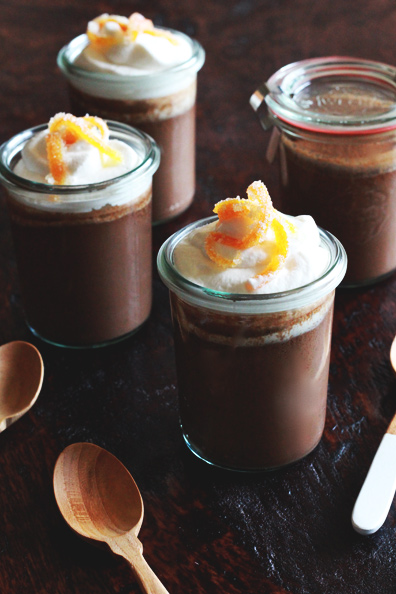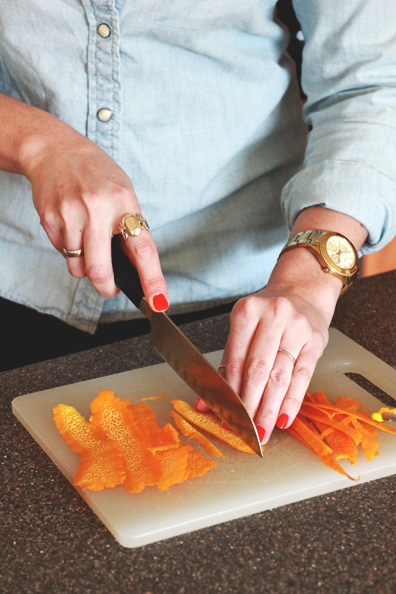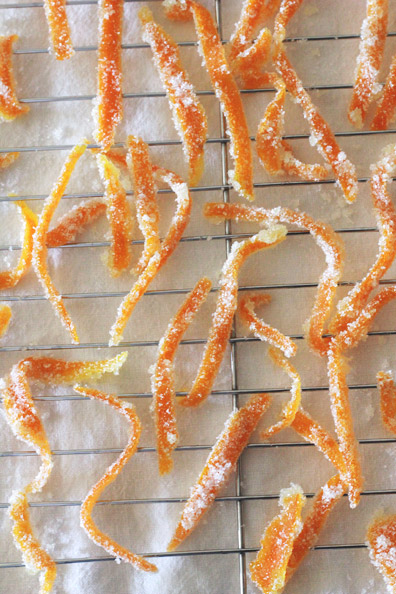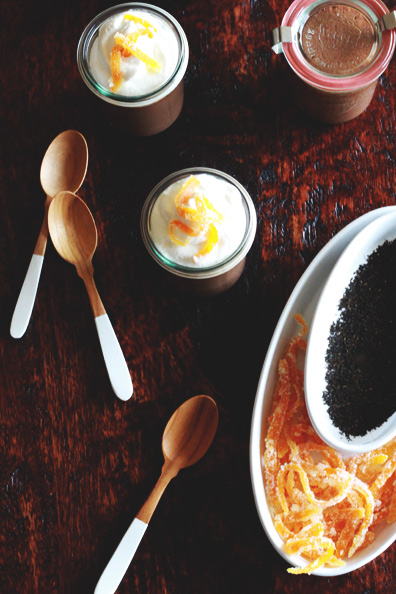Elizabeth’s back today with this month’s installment of One Last Bite.
They tell me Spring has sprung, but up here in Wisconsin the nights are still chilly enough to make me want to snuggle under a soft blanket with a mug of hot, spiced tea. April is a transition month—it’s a tease. For today’s post, I looked for a recipe that would use up what we have left in our kitchens as we anticipate the arrival of warm-weather ingredients. The items that stood out in my kitchen: tea, oranges, chocolate, vanilla bean, and cream. Together, they make my favorite recipe that I have shared with you thus far: earl grey and chocolate pots de crème (pronounced POH-duh-crehm). Denser than a pudding, this custard’s creamy texture and deep bergamot and bittersweet chocolate flavors compliment the bright tang of sticky candied orange peel, sparkling with sugar.
I had hoped to find a recipe that would embody this transitional season. What I ended up with is a sweet treat that could be enjoyed while snuggled up in a blanket by the blazing fireplace—or during a backyard summer dinner party lit by the stars. Here’s to spring, to transition, to anticipation of everything this year will bring.
Earl Grey Chocolate Pots de Crème with Candied Orange Peel
3 Tbsp. (about 9 teabags, emptied into a dish) earl grey tea
1 1/2 cups heavy cream
1 1/2 cups milk (whole or 2%)
5 oz. bittersweet chocolate, chopped
8 large egg yolks*
3/4 cup granulated sugar
a pinch of salt
1 vanilla bean, scraped
whipped cream
candied orange peel (recipe follows)
* Leftover egg whites can be frozen in an airtight container for up to one year. To use, defrost in the refrigerator overnight.
Slowly heat the cream and milk in a saucepan until very hot, but not boiling. Remove from heat and add the tea leaves. Let steep for 30 minutes or as long as two hours. After the tea has steeped, add the vanilla bean scrapings and gently heat again until very hot, but not boiling. Remove from heat and add the chopped chocolate. Let sit, stirring every so often, and whisk until smooth. Preheat oven to 325 degrees. Line a roasting pan with a dish towel, place 6 to 8 oven-safe ramekins, jars, or bowls on top of the towel, and set aside. (The yield will depend on the size of the ramekins/jars. The recipe filled six 6-oz ramekins perfectly.)
Whisk egg yolks, sugar, and salt in a medium bowl. Pour a small amount of the hot chocolate mixture into the eggs and sugar and whisk well. (This will warm the eggs so that they won’t curdle when you more of the warm chocolate mixture). Add the rest of the chocolate mixture in a slow, steady stream while whisking with gentle, slow strokes. (Don’t whisk too vigorously—you don’t want too many air bubbles.) When all the hot chocolate mixture has been added, strain through a fine mesh sieve into a large glass measuring cup with a spout and fill the ramekins or jars leaving about 1/4- to 1/2-inch of headspace. Place roasting pan in oven and carefully pour hot water (from the tap or tea kettle) around the ramekins until the water reaches about 1” up the sides of the ramekins. Bake undisturbed for about 40-45 minutes.
During this time you can prepare the orange peel. After 40 minutes, give one of the ramekins a little shake. It should wobble a bit in the center, but not be too jiggly. Remove roasting pan from oven, being very careful not to slosh any water into the custards. Let custards cool in the water bath for about 10 minutes. Remove custards from the water bath and let finish cooling. Chill until very cold. Serve with a dollop of whipped cream and a few strips of candied orange peel.
*Recipe adapted from Lindsay Johnson
Candied Orange Peel
One organic navel or valencia orange with a smooth, unblemished peel
2/3 cups sugar
4 2/3 cups water
Using a vegetable peeler, remove wide strips of zest from the orange. (Take care to remove only the orange surface and not the white pith underneath.) Slice the zest into 1/4-inch-wide julienne strips. In a saucepan, cover the strips with 2 cups of water, bring to a boil and cook for 10 seconds. Drain in a strainer and rinse the strips under cold water. Repeat the blanching process once more: cover the strips with 2 cups of water, bring to a boil, cook for ten seconds, drain, and rinse under cool water. Return the zest strips to the saucepan with 1/3 cup of sugar and 2/3 cup of water. Bring to a boil and cook, uncovered, until the mixture starts to thicken, about 8 minutes. At this point, the syrup should be a bit gooey and the zest strips should be almost transparent. A rubber spatula drawn through the syrup will leave behind a path that will take a few seconds to disappear. Spread 1/3 cup of sugar on a tray. Use tongs to remove the peels from the syrup and shake them off over the pan before you place them in the sugar. Toss the strips in the sugar, separating the pieces so that each strip is coated with sugar. Transfer the strips to a plate; let stand for at least half an hour, until dry. Store in a container with a tight-fitting lid.
*Post by Elizabeth Ansfield, photos by Lauren Craig





